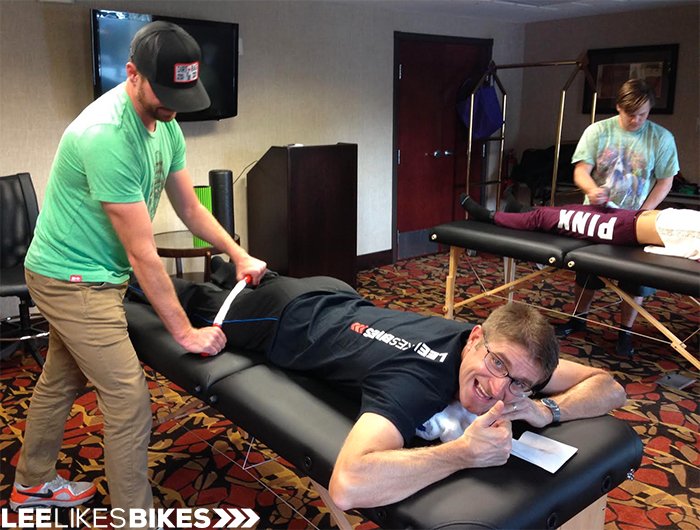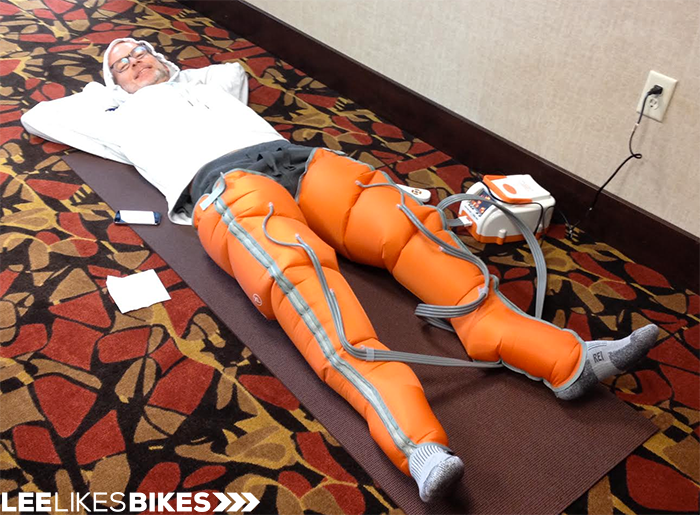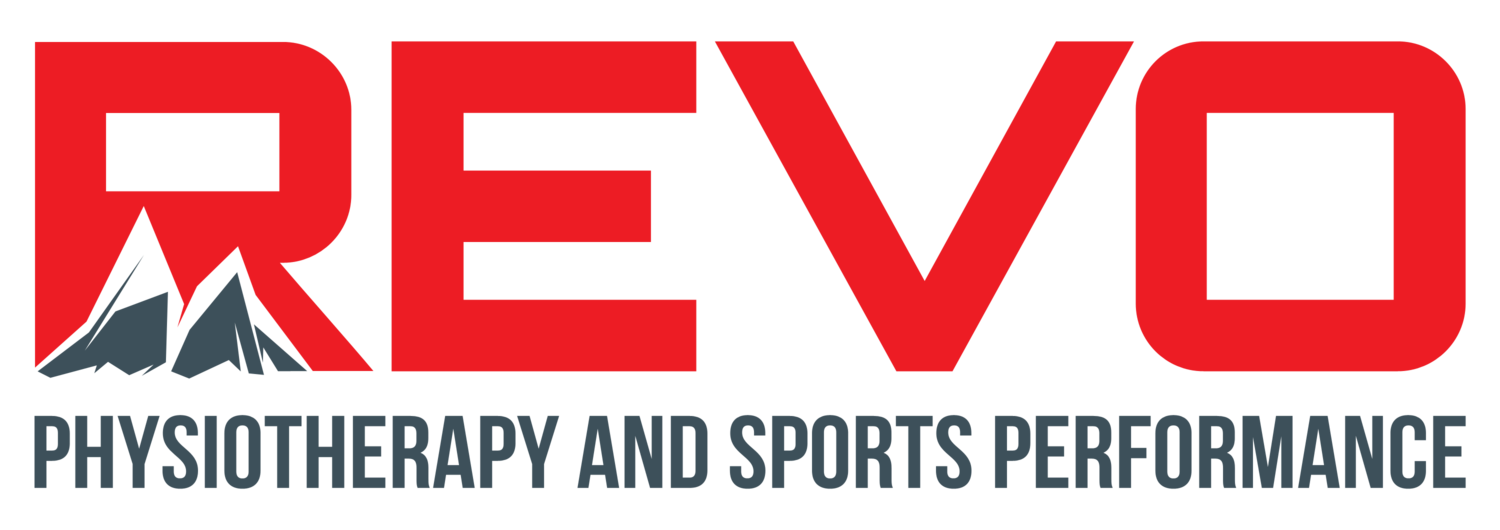Recovering from hard rides

Lee
The end-of-day recovery from your four day clinic (LLB Moab Camp Oct. 22-25, 2015) is very interesting to me. As I am 54 I find this is becoming extremely important. What can I do to learn about the best recovery for me?
Chris
Chris!
Thanks for the question. I loved everything about the LLB Spring 2015 Moab Camp, but my favorite part was the after-ride recovery.
Each rider got a different treatment based on his or her needs, but basically:
Ride all day.
Meet the guys from REVO Physiotherapy & Sports Performance in the hotel conference room.
30 minutes in compression boots. These pump the bad stuff out of your legs – and they feel great.
Get on the table, and the guys do manual work on you. Trigger point therapy, deep-tissue massage, mobility or whatever you need.
Wake up feeling young and fresh.
Repeat!

These boots squeeze yuck out of your legs like that last bit of toothpaste, and you feel great the next morning! Fred was stoked at the LLB Spring 2015 camp.

Dane works out some kinks in Phil’s impressive legs. Phil’s been on a Strava KOM tear since the LLB Spring 2015 camp.
Since I’m first learning about this stuff, I posed your question to Dane DeLozier, one of the founders of REVO Physiotherapy & Sports Performance here in Boulder, CO. Dane and his teammates Brian and Matt have helped me tremendously with managing my injuries and getting stronger.
Dane says:
Recovery is a hot topic in the health and fitness industry lately. As riders age and continue to get rad regularly there are some necessary steps to ensure the body is functioning optimally.
As a cyclist myself I will relate this to bike maintenance. We’ve all heard to term “ridden hard and put away wet.” We wouldn’t expect to ride our favorite trail bike hard in the mud and have it perform optimally the next day without proper maintenance. Care for the bike or it will fail.
Why do we not expect this to be the same with out own bodies? Our bodies are excellent at adapting to the crazy stresses we apply to them, but more often than not we can help improve this process. The harder we ride the harder we have to recover, simple as that.
Recovery can be a complicated concept and is generally specific to individuals but there are a few basic concepts that any cyclist can apply to their recovery program that will add immediate benefit.
Move! The worst thing to do after a hard ride is sit down in the truck for the trip home. Unfortunately this is reality following most trail rides. A proper cool down is essential to reap full benefit from your training session. Going from 60-0mph is just as harmful as going 0-60mph without proper warm up. Try a 10 min easy spin before getting in the truck — and feel better!
Lee: I do huge (20- to 40-minute) warmups, and I do my best to cool down easily.
Mobility. This can be used as an umbrella term to cover a lot of concepts. Cyclists need to first think of mobilizing soft tissue structures stressed during a ride (think muscle and fascia). Specifically: butt, thigh, calf groups. Hop on a foam roller or a lacrosse ball and rock side to side on these tissues. If you find a painful spot that makes you want to curse my name, good! That’s an important spot. Keep it up until that spot feels better. Breathe into this mobility work. Holding your breath will only cause you to tense up and increase the pain sensation. Relax into the roller and look for tender points throughout the entire muscle.
Lee: This isn’t much fun, but it really helps. I work my shoulder with a lacrosse ball while I’m driving, and I use a vibrating foam roller before teaching and riding. At night I use a lacrosse ball or Thera Cane on my shoulders, which have turned into a full time job.
Compression. If you want to get more serious about recovery, pneumatic compression boots are a great option. There are various companies offering this type of modality but the basic treatment framework is the same. Compression boots are applied to both legs, a pneumatic pump applies sequential pressure throughout several cambers in the boots. This pressure is used to aid the normal circulatory return process by pushing fluids near the foot/ankle closer to the core. This often results in “fresh” feeling legs following aggressive efforts.
Lee: This is so good! I’ve only used them at our Moab camp, but — man — I wish I owned a set.
Trigger point dry needling. This technique, often performed by a physical therapist, involves placing a very thin needle directly into the muscle at the site of a trigger point. The needle often shocks the muscle into relaxing. An overused muscle will commonly display these active trigger points and will benefit from trigger point dry needling. Allowing these trigger points to remain can decrease performance and cause pain at the site of the trigger point and even referred pain far away from the trigger point. If you have trouble addressing a problem trigger point with the foam roller, trigger point dry needling may be the answer.
Lee: This isn’t for everyone, but it’s the only way to release the mess that forms in my shoulders. I also get regular dry needling to reset the muscles in my back, hips and thighs. Warning: Make sure you have an easy day or two after this therapy — you’ll be sore.
Each of these treatment techniques could be a single blog post on their own (stay tuned!) but first try these basic concepts and talk to your physical therapist about compression treatments or trigger point dry needling if you are curious.
You buy a pro bike, you work on your skills like a pro, recover like a pro and feel the difference!
Dr. Dane N. DeLozier, PT, DPT, ATC, NASM-PES
REVO Physiotherapy & Sports Performance
Dr. of Physio and Movement Lab Director
Boulder, Colorado, USA
Have fun out there,
Lee
Know more. Have more fun!
Join the leelikesbikes mailing list:


Leave a Reply
Want to join the discussion?Feel free to contribute!